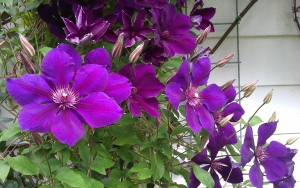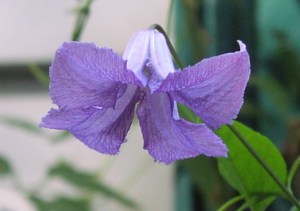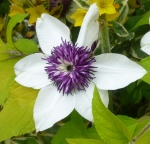Early crocus, daffodils, and tulips are tentatively poking their heads up out of the soil to test the waters (so to speak). My witchhazel is blooming. The fragrance of the Sarcococca knocks my socks off every time I go in or out the door. The Northwest Flower & Garden Show is next month. The weather has been unseasonably warm here in Seattle (though a bit drippy). So, of course, I have an early form of spring fever! I really should get outside and finish pruning my Group 3 clematis (the ones that bloom in July and August on new wood), but instead, I stayed inside and drooled over the offerings from my three favorite online mail-order sources for clematis: Silver Star Vinery, Joy Creek Nursery, and Brushwood Nursery.
Three of My Favorite Clematis
Before I get started, though, I will pause to recommend, both to beginners and to old hands a like, three of my personal favorite clematis, all which are available at all three mail-order nurseries.

Clematis ‘Gipsy Queen’
Clematis ‘Gipsy Queen’
This clematis has sumptuous and velvety deep dark purple flowers with rich red overtones on opening, then ages to a lighter reddish purple. It always stops me in my tracks whenever I see it in bloom (even if I just saw it a minute ago!). This large clematis (up to 12 or 14 feet) is always recognizable to me, even from a distance, for its size, its lush purple color, and the spacy-ness of its flowers. Its tepals spread out gracefully, leaving space between them, especially at the base, where the tepals narrow near the center of the flower like the base of a spoon, adding a special charm. C. ‘Gipsy Queen’, a sun lover, is easy to grow and comes on strong (at least for me) in late July and August when so many of my other clematis are beginning to wind down.

C. ‘Guernsey Cream’
Clematis ‘Guernsey Cream’
C. ‘Guernsey Cream’ is usually the first large-flowered clematis to bloom in my garden in spring, sometimes as early as mid-May. I am always so happy to see it’s rich creamy blossoms, sometimes with green overtones. It blooms luxuriantly for several weeks before resting for a time. If I cut it back a bit after blooming, I may get a few more blooms in the autumn. Several clematarian friends advise me to boldly cut it back really hard to get many more blooms in the second flush. I’ll try, really, I will.

Clematis Betty Corning
Clematis ‘Betty Corning’
The third of my favorites is the delightful and dainty C. ‘Betty Corning’, with its open bell-shape and soft mauvey-blue color, which shows well when paired with many other clematis or with roses. It blooms its little heart out in July and August. The pièce de résistance of this clematis, though, is its lovely light fragrance that wafts around the garden on a warm summer day. It’s another one that I just can’t be without!
Three More Recommendations from Each Nursery
Brushwood Nursery
As I perused offerings from this nursery, which has all kinds of vines, not just clematis, I chose three excellent clematis to recommend to you that I grow myself.
 Clematis ‘Fair Rosamond’
Clematis ‘Fair Rosamond’
A beautiful and easy-care early-blooming white clematis with a contrasting dark-red boss (which is all those reproductive parts clustered together in the middle of the flower). This 7-9′ vine would pair nicely with a dark-leaved small tree like Forest Pansy Redbud. It blooms in June and has a very light fragrance of violets.

C. ‘Etoile de Malicorne’
Clematis Etoile de Malicorne
This is a two-tone large-flowered spring bloomer that blends well with dark blues, dark pinks, purples, and whites. I grow it to great effect with C. ‘Ville de Lyon’, an intensely pink clematis with rounded tepals (see a photo of this clematis under Silver Star Vinery below)–though their bloom times just barely overlap. This tall plant, growing to 9-12′, blooms in May/June and pushes out a few blossoms again in the autumn, if you’re lucky.

C. florida ‘Sieboldii’
Clematis florida ‘Sieboldii’
A real stunner, C. florida ‘Sieboldii’ blooms in July and August and looks good with just about anything! It bloomed so well for me in the back garden that I had to have one for the front garden, too. It has a reputation for being a bid persnickety. Some years it blooms beautifully, then the next has only a few flowers. But in this case, even one flower is worthwhile.
Click the links below to see which clematis from Brushwood I am thinking about ordering for myself:
Clematis ‘Vancouver Fragrant Star’, because it’s fragrant.
Clematis ‘Vanessa’, because I’ve met Vanessa and because it blooms in late summer and fall.
Clematis ‘Lady Betty Balfour’, because it also blooms in late summer and fall.
Joy Creek Nursery
Joy Creek Nursery offers many kinds of plants, but fortunately for me clematis are one of their specialties. Here are three they offer that I enjoy having in my garden.

C. ‘Asao’
Clematis ‘Asao’
C. Asao is a Japanese hybrid that blooms in May and June. The flowers are pink, gradually morphing to nearly white at the base of the tepals, nicely setting off the yellow center. This clematis often has just a few extra tepals–not enough to call it double, but enough to give the flowers a ruffly look.

Clematis Alba Plena
C. ‘Alba Plena’
This unusual and gorgeous clematis is in Pruning Group C, which means it is easy to prune (just cut it back hard in winter or early spring) and that it blooms on new wood in July and August. It’s unusual greenish-white blossoms have a large boss in the center. Sometimes this plant can be a bit finicky to establish, but the effort certainly pays off!

Clematis ‘Pauline’
C. ‘Pauline’
C. ‘Pauline’ is a spring bloomer with sweet little nodding bells and delicate leaves. I love how the dark purple color stands out against the greenery. Being an alpina type of clematis, this one doesn’t need pruning every year, though after a few years it may develop a ratty look and need a rejuvenation. It enjoys partial shade–the dappled shade of a deciduous tree suits it perfectly.
Three of the clematis that caught my eye at Joy Creek Nursery are:
Clematis ‘Candida’, because I loved it in my Boston garden–it’s flowers are so large and lovely (sorry, no photo at Joy Creek, but you can see one here.)
Clematis ‘Haizawa’, because it’s adorable — and I saw a robust specimen last summer in a Seattle garden.
Clematis ‘Obotozukiyo’, because it is so delicately pretty.
Silver Star Vinery

C. Star of India
The blossoms of C. ‘Star of India’ are a rich purple with a stand-out red stripe in the center. The fat tepals overlap, making for a rounded form. This beauty sports its blossoms in July and August on 9-12 foot vines. Because it’s a summer bloomer and blooms on new wood, it’s easy to prune (cut it back hard). Great for any garden with full sun.

C. Ville de Lyon
Another beauty, C. ‘Ville de Lyon’ is intensely pink with the outer rim of each tepal even darker than the inside. Once you’ve seen this one in bloom, you will always recognize it. It’s a tall clematis, often growing to 15 feet. Because it’s a heat lover, be sure to plant it in a hot sunny spot (keeping it well-watered, of course).

C. Romantika
A really dark rich color that stands out when placed against a light background such as Lonicera nitida ‘Baggesons Gold.’ Blooming in summer with numerous small flowers, it always catches the eye of visitors to my garden. Easy care, just needing a hard prune in winter.
The clematis below are calling my name from Silver Star Vinery. There may be more than one clematis per page, so you might have to scroll down to find the clematis I’m interested in:
Clematis ‘Arabella’, because I’ve admired it in so many gardens
Clematis ‘Barbara Harrington’, because I’ve admired it in the Silver Star Vinery display garden.
Clematis ‘Kasagai’, because I never heard of it and there’s no picture. Tantalizing.
I hope all this eye candy will encourage you to buy a new clematis or two!














































































































